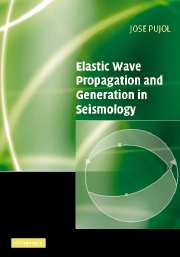Book contents
- Frontmatter
- Contents
- Preface
- Acknowledgements
- 1 Introduction to tensors and dyadics
- 2 Deformation. Strain and rotation tensors
- 3 The stress tensor
- 4 Linear elasticity – the elastic wave equation
- 5 Scalar and elastic waves in unbounded media
- 6 Plane waves in simple models with plane boundaries
- 7 Surface waves in simple models – dispersive waves
- 8 Ray theory
- 9 Seismic point sources in unbounded homogeneous media
- 10 The earthquake source in unbounded media
- 11 Anelastic attenuation
- Hints
- Appendices
- Bibliography
- Index
10 - The earthquake source in unbounded media
Published online by Cambridge University Press: 12 November 2009
- Frontmatter
- Contents
- Preface
- Acknowledgements
- 1 Introduction to tensors and dyadics
- 2 Deformation. Strain and rotation tensors
- 3 The stress tensor
- 4 Linear elasticity – the elastic wave equation
- 5 Scalar and elastic waves in unbounded media
- 6 Plane waves in simple models with plane boundaries
- 7 Surface waves in simple models – dispersive waves
- 8 Ray theory
- 9 Seismic point sources in unbounded homogeneous media
- 10 The earthquake source in unbounded media
- 11 Anelastic attenuation
- Hints
- Appendices
- Bibliography
- Index
Summary
Introduction
Most earthquakes can be represented by slip on a fault, which for simplicity will be modeled as a planar feature. When an earthquake occurs, the two sides of the fault suffer a sudden relative displacement with respect to each other, which in turn is the source of seismic waves. Assuming that the Earth is initially at rest and that there are no external forces, the occurrence of an earthquake is the result of a localized and temporary breakdown of the stress–strain relationship, which is the only basic equation of elasticity that is not a fundamental law of physics (Backus and Mulcahy, 1976). Let us compare this situation with that encountered in Chapter 9. There we used (9.4.2) to study the displacement field caused by a given body force, while here the displacement at points away from the fault is caused by a discontinuity in displacement across the fault, and because of the breakdown of Hooke's law, we cannot use (9.4.2) directly. Therefore, we are faced with the following problem: what is the equivalent body force that in the absence of the fault will cause exactly the same displacement field as slip on the fault. Getting an answer to this question took a considerable amount of time and effort (for a review, see Stauder, 1962). As a result of work done during the 1920–50s, two possible models were introduced, based on single and double couples similar to those discussed in Chapter 9.
- Type
- Chapter
- Information
- Elastic Wave Propagation and Generation in Seismology , pp. 316 - 356Publisher: Cambridge University PressPrint publication year: 2003
- 1
- Cited by



